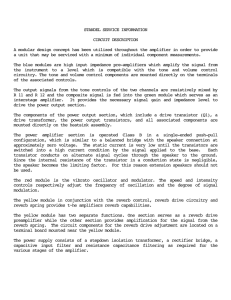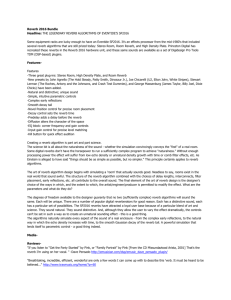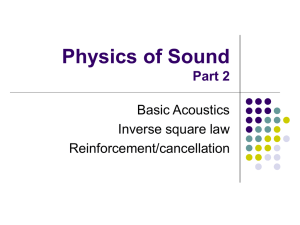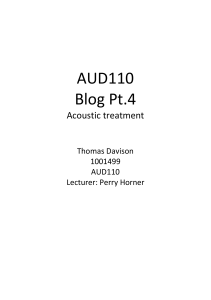Spring Reverb Documentation
advertisement
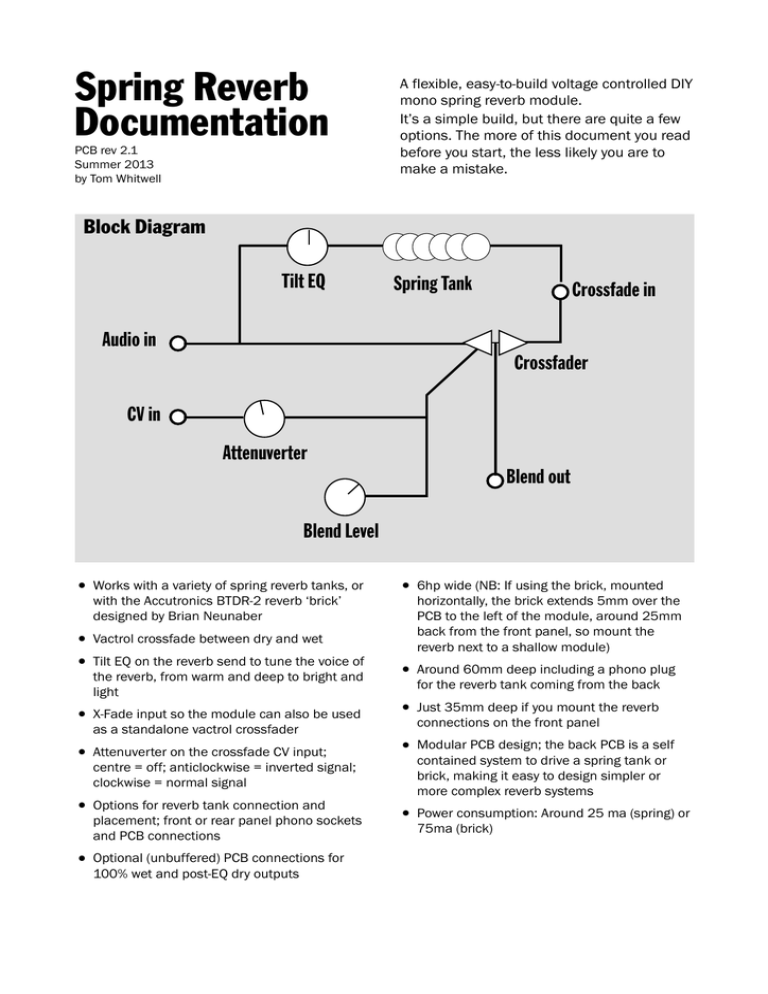
Spring Reverb Documentation PCB rev 2.1 Summer 2013 by Tom Whitwell A flexible, easy-to-build voltage controlled DIY mono spring reverb module. It’s a simple build, but there are quite a few options. The more of this document you read before you start, the less likely you are to make a mistake. Block Diagram Tilt EQ Spring Tank Crossfade in Audio in Crossfader CV in Attenuverter Blend out Blend Level • Works with a variety of spring reverb tanks, or • 6hp wide (NB: If using the brick, mounted • Vactrol crossfade between dry and wet • Tilt EQ on the reverb send to tune the voice of • Around 60mm deep including a phono plug with the Accutronics BTDR-2 reverb ‘brick’ designed by Brian Neunaber the reverb, from warm and deep to bright and light horizontally, the brick extends 5mm over the PCB to the left of the module, around 25mm back from the front panel, so mount the reverb next to a shallow module) for the reverb tank coming from the back • X-Fade input so the module can also be used • Just 35mm deep if you mount the reverb • Attenuverter on the crossfade CV input; • Modular PCB design; the back PCB is a self • Options for reverb tank connection and • Power consumption: Around 25 ma (spring) or as a standalone vactrol crossfader centre = off; anticlockwise = inverted signal; clockwise = normal signal placement; front or rear panel phono sockets and PCB connections • Optional (unbuffered) PCB connections for 100% wet and post-EQ dry outputs connections on the front panel contained system to drive a spring tank or brick, making it easy to design simpler or more complex reverb systems 75ma (brick) Using the module, and how to get the best possible sound I’m very happy with how this circuit sounds, particularly in this demo: http://snd.sc/16o6GvG But it’s not always easy to coax such smooth tones from a spring reverb. Don’t assume there is a fault with your module if you don’t immediately get this kind of sound I made that mistake a few times on breadboard. Here’s what I’ve learned about getting a good, rich, warm, clean sound: •What you get out depends on what you put in. By far the biggest factor in the tone of the reverb is - obviously - the tone being fed into it. Software reverbs can put the same smooth mushy sound over whatever your run into them. This isn’t like that at all. Remember that it’s a physical system moving about, driven by magnets and electricity and springs. the tank. Try shifting it through 90 degrees - on whichever axis is practical - and often the hum will drop. If you want to mount your tank inside a case, experiment with the exact position to find the quietest spot before fixing anything. •Noise (hiss, white noise, not hum) is caused by the high-gain op amp in the recovery section. I’ve tried to reduce it as far as possible by using low-impedance resistors. I also tried two lower-gain op amps in series, which seriously increased the noise. It may be that using other dual op-amps could reduce this noise even further. Or just think of it as tape hiss, adding mojo. •Spring reverb is chaotic and hard to predict. Spring reverb is a strange, gnarly, physical effect. When I tried to calibrate and measure this circuit, I’d find that a sine wave at, for example, 400hz, might barely excite the springs at all, while a sine at 405hz would bust them into fuzzy overdrive. Change a component, and that response changes completely. How to use the controls I’ve found that smooth, clean, FM-ed sinewaves work very well with the springs. On a ‘scope, the output looks similar to the input, but more complicated. On the other hand, square waves try to bash the springs about. There’s no way that a magnet can move a spring in anything like a square wave, so the sound coming out will sound little like a square wave. On a ‘scope, it’s more like a filter or waveshaper. Tilt Small changes in the input sound can be amplified and enhanced by the reverb. Blend •Choice of spring tank is not absolutely critical. Big long six spring tanks will sound bigger than small tanks, but I’ve found that - at least with my limited selection - it is less important than the other factors in this list. I got pretty good reverb from the tiny plastic-boxed new reverb that Belton are developing. You can use EQ to compensate for the choice of tank to some extent. •Hum is caused (and can often be cured) by the exact position of the tank. A reverb tank is not unlike a big, highly amplified singlecoil guitar pickup. It will pick up 50/60hz mains hum, particularly from transformers but probably also from dimmer switches or fluorescent tubes. That hum can often be stopped completely by moving the tank away from the source or - often more practically - by just changing the position of Is a hifi-style EQ control based on the Ambler circuit from 1970. It controls the signal sent to the reverb, but has no effect on the dry signal. At 12 o’clock, it is flat. Turned clockwise, it boosts frequencies above 1,000hz, and cuts frequencies below, by up to 8dB. Turned anticlockwise it cuts treble and boosts bass. Controls the mix between clean and reverb outputs, between dry and wet. Control This attenuates or inverts the CV input for the blend control. At 12 o’clock, the CV is attenuated (although if you want it to go completely, it’s much easier to pull out the plug). Clockwise, voltages are added to the blend control; high input voltage = more reverb. Anti-clockwise, they’re inverted; high input voltage = less reverb. X-Fade Input Audio input here will replace the ‘wet’ reverb signal in the crossfader, so the module can be used as a standalone vactrol crossfader. Reverb cannot be heard in this mode. Building the module, and choices you’ll need to make before you start Summary: Which values should I use in the unmarked spaces? Before you start: R7 depends on the vactrol. Silonex 32SR3 = 470Ω VTL5C3 = 47k This PCB was built to be flexible. Before building, you’ll have to take four decisions: 1: Tank or Brick? The rear PCB has space for two separate drive & recovery circuits; one for a reverb tank and one for the Accutronics BTDR-2 reverb brick. The real tank sounds better, but is physically bigger and liable to hum. The brick is small and selfcontained, with a distinctive reverb based on PT2399 delay chips. Only build the circuit you will be using; If building for a spring, ignore all components in the ‘Brick’ area. If building for a brick, ignore all components in the ‘Spring’ area. It is also possible to build both circuits and attach a switch in place of the jumper, to make the module switchable between spring and brick 2: Which vactrol? I’ve tested the circuit with VTL5C3 and Silonex 32SR3 vactrols. Both work well, and the value of R7 needs to change: Silonex 32SR3 470Ω VTL5C3 47k If you’re using a DIY vactrol or another brand, R7 should be chosen experimentally. 3. Where will you put the tank? Inside the case The rear PCB has space for phono sockets so that you can easily mount a reverb tank either inside your case. There’s a risk that your PSU will create hum that is picked up by the tank, so experiment with the position and orientation of the tank. Out the back of the case If you have, or can make, a suitable hole in the back of your case, probably the best way to mount your tank is outside Hanging a tank on the wall behind your modular is a good way to cut down unwanted vibration and avoid transformer hum, or the tank can be left on top of the modular where then can Tested spring specs are: Input: 150Ω to 800Ω Output: 2,250Ω to 2,575Ω Insulated input, Grounded output Beyond this range, you may need to do some research or experimentation. be shaken or strummed, or next to a speaker to encourage feedback. Out of the front of the case There is an alternative version of the front panel with space for two chassis-mounted phono sockets, so you can patch the reverb tank into the front. It makes for a snug front panel, but is the shallowest and most skiff-friendly solution. 4a: Which Tank? Short version: If you’re buying a new tank, I’d recommend one of these fairly common models: Accutronics 9EB2C1B A big 17” long reverb tank with six springs. Accutronics 8EB2C1B A smaller 10” version with three springs. This is the tank from a Fender Blues Junior amp, so is very common. Other makes with the same number (i.e. MOD 8EB2C1B ) will work in the same way. The Ruby 3EB2C1B also looks nice. Long version: The circuit has to be tailored to the specific tank you use. It’s designed to be flexible, but I don’t have hundreds of tanks lying around to test it with. Here’s how Accutronics/Belton codes work, using the top tank as an example: 9EB2C1B 9 = The type of tank - the size, number of springs etc. The circuit doesn’t care, but the sound will be different. This circuit is designed for C type tanks. You might need to change the circuit significantly to use other types. That said, I’ve run my Blues Junior with the reverb connected entirely the wrong way round. It still worked, but certainly sounded better the right way around. 1 = Locking Devices B = Mounting orientation The circuit doesn’t care about either of these. E = The input impedance; A = 8-10 Ω B = 150 - 190 Ω C = 200 - 240 Ω D = 250 - 310 Ω E = 600 - 800 Ω F = 1,475 - 1,925 Ω The lower numbers are for Type 4 tanks, higher for Type 8 & 9 tanks. I’ve tested the circuit with various impedances between 150 and 800 Ω. Very low impedances may pull more current than is available from the TL072 driver. Very high impedances might require swapping the 10k trimmer for a 100k trimmer. B = Output Impedance A = 500 - 600 Ω B = 2,250 - 2,575 Ω C = 10,000 - 12,000 Ω I’ve only tested this circuit with B type tanks. To adapt to other impedances you’d need to change the values of R4 and R6. 4b: Which Brick? There are two types of BTDR-2, depending on the orientation. Either should work, but I’ve only tested mine with a BTDR-2H, which lies parallel to the PCB. The BTDR-2H will lie flat against the back of the module, poking 5mm out of the left side. The BTDR-2V will poke out of the back of the module, extending the depth to around 60mm, and poking out a couple of millimeters on the right hand side. Either solder the brick directly to the PCB, which is sturdy and low profile, or mount it in a bit of female header, which adds a couple of centimeters of depth. You probably wouldn’t solder a chip worth £15 to a board without a socket, would you? Other Options There are lots of options on the board to help you build the reverb you want. All the sockets are pulled out to tags on the front board. On the back board there are outputs for the Post EQ, pre Reverb signal and the Post reverb, pre Blend (100% wet) signal. The rear board is a stand-alone reverb circuit, and the front board should act as a modular-level EQ/Blend circuit receiving power from the rear board. 2 = Decay Time The circuit doesn’t care C = Connections A = Input Grounded / Output Grounded B = Input Grounded / Output Insulated C = Input Insulated / Output Grounded D = Input Insulated / Output Insulated NB: This board assumes Red=Output, White=Input. Check your tank carefully. The mini tanks that come with a Doepfer A199 are sometimes coded differently. Two Accutronics Blue reverbs mounted in a Hammond 1590XX enclosure Building the circuit First run calibration Bill of Materials The calibration procedure is pretty straightforward. If you don’t get it right first time, go back and try again. Most of the components are straightforward offthe-shelf parts, but the parallel PCB construction means some components are very specific. Sockets: The board is designed for 3.5mm vertical jacks from Erthenvar or Thonk: model PJ-301b. Other jacks may work, you’ll probably need to wire the grounds together. Potentiometers: Many 9mm vertical-mount pots will fit on the board. Ideally, for maximum module strength and stability, use pots that mount to the panel, like the Alpha RD901F-40-15R range available from Smallbear (7mm mounting holes) or the Alps RK09L range (9mm mounting holes) The Blend pot is a voltage divider; any Linear pot above 10k should work fine. The CV Control attenuverter circuit is setup for a 50k pot, but I’ve used 100k in this slot without a big impact. The EQ circuit is set up for 10k with values deliberately low to reduce noise. The circuit will still work with other values, but the maximum gain/cut may be more extreme, causing clipping at some settings. Op Amps: I specified a NE5532 for the EQ section, but another TL072 will perform fine. Unfortunately, I had little luck with the 5532 in the critical spring recovery circuit, where the lower noise would be helpful. Vactrols: The Silonex NSL-32SR3 has a white spot next to the negative LED lead. The resistor leads are the long thin ones. It’s a pretty tight fit, but the Silonex and VTL5C3 will both fit on the board. Once the module is fully built, with all the ICs in their sockets, connect the module to power in your case (or a separate PSU, if you have one). Connect the spring reverb, being careful to get the ins and outs the right way around. Don’t screw the module into the case, you’ll need access to the trimmer on the back. •Connect an oscillator (ideally, the loudest sine or triangle oscillator in your modular) to the input. •Connect the spring module output to your output/mixer etc. Turn down your speakers! It might get loud (it might also be very quiet) •Set the oscillator to a middle/low frequency not sub-bass or very high pitched. Use an LFO or a sequencer to constantly vary the pitch. It doesn’t matter what it’s doing, but you can’t really hear reverb on a static pitch. •Set the CV and Tilt controls to 12 o’clock. •Pan the blend control from 7 o’clock to 5 o’clock. You should be able to hear the clean, dry signal at 7, and some kind of reverbed signal at 5. The reverb level might be very low or very loud and distorted •With the blend control at 5 o’clock (fully wet) start moving the screw on the trim pot clockwise. •Listen to the reverb output, which should get gradually either louder or quieter. If it doesn’t change, start moving anticlockwise instead. •Once you’ve got the hang of it, adjust the reverb output until it just starts to distort, then move back a bit so that it’s clean. You want it as loud as possible, before distortion. •Sweep the oscillator frequency up and down to ensure it doesn’t distort. If you like, try a few other oscillators in your system, or an oscillating filter. Try whatever makes loud noises, to check it won’t overdrive the spring. •Sweep the blend control back to 100% dry. Hopefully the dry and wet signal levels are reasonably well balanced. If not, maybe push the spring a little harder. •After a while using the reverb, you may want to go back to tweak the gain to taste. LEDs I’ve tested the board with both superbright and regular 3mm LEDs, both seem to work fine. Be careful about changing R11 to make the LED brighter or dimmer as it will also change the Vactrol LED brightness, potentially changing the sound. Populating the board Is hopefully straightforward - build in the normal way, resistors first, then capacitors, transistors, sockets, hardware. Front board = the board with sockets and pots. Back board = the board with the power header. Take care to study the silkscreen and photographs to ensure components are on the correct side. Both boards are double-sided with components on both sides. Particularly watch out for: Type 1 PCB mounted phono jacks for the spring reverb tank on the back Type 2 An Accutronics reverb ‘brick’ on the back •C12, the capacitor behind the the sockets on the front board must be soldered before the sockets •The little 5 pin jumper that runs between the front and back boards. Fit the male and female halves together, put it in place, screw the boards together, then solder. It doesn’t matter which side is male or female. •The back board is particularly double-sided; the phono jacks, power header, trimmer, spring/brick jumper and Brick are all mounted on the rear of the back board. All other components, including the rest of the power circuit are on the front of the back board (between the two boards). •I’ve accidentally soldered the power header to the wrong side of the board before. It’s a real pain to remove, and you have to sacrifice the entire header to get it out. It’s best to attach the LED right at the end. When the front board is finished, put the LED into the board (the longer lead goes into the + hole) but don’t solder it. Loosely fit the front panel and finger tighten a couple of nuts. Place the LED Type 3 Phono jacks for the PCB mounted on the front panel into the hole in the front panel, then solder it into place before assembling the rest of the module. Troubleshooting & mods If the reverb level is too low after calibration, consider changing R6 from 22k to 47k. R6 sets the gain for the recovery circuit. The downside is that this may cause increased hum and risk of feedback. It is possible to build both spring and brick circuits, then attach a simple SPDT switch to the jumper to switch between the two reverb types. There are solder points on the back board for Post EQ and 100% outputs which could be pulled out to front panel sockets. These aren’t buffered, so inserting a plug may change the reverbed output. It would be easy enough to hack two buffers from the TL072 in the ‘Brick’ section . Patch ideas Feedback Ingredients; Spring Reverb + Filter with two input channels (or filter + mixer) 1) Mult the Spring output to your speakers, and to one input channel on the filter 2) Take the input source (if required) to the other filter input. 3) Connect the filter output to the spring input. 4) Turn the volumes up carefully until the whole circuit starts to feed back. 5) Bandpass filters are particularly fun here sweeping the filter tunes the feedback. Gated / reverse reverb Ingredients: Spring Reverb + Make Noise Maths + oscillator + VCA 1) Set up the right side of a Maths as an envelope controlling the VCA to create a string of short audio pulses / blips. 2) Connect EOC to the left side TRIG. Ensure left side is not in cycle mode. 3) Connect the EOR output to the Spring CV input. Set the blend to 7 o’clock and Control to 5 o’clock. Listen to the spring reverb output. 4) The Spring LED should now flash in time with the audio pulses. Left hand Rise control sets the length of the reverb. 5) Switch the Spring CV input from EOR to the envelope out to get pseudo-reverse reverb. Send your patch ideas to: tom.whitwell@gmail.com Open Source Hardware This is an open hardware project. You are free to build this hardware, sell it or make any changes to it, so long as you share your changes and release them under the same license. You should also credit me, Tom Whitwell. All of the original design files (Eagle CAD, Illustrator etc) are shared. These files are licensed under a Creative Commons Attribution Share-Alike license, which allows for both personal and commercial derivative works, as long as they credit me and release your own interpretation under the same license. This work is licensed under the Creative Commons Attribution-ShareAlike 3.0 Unported License. To view a copy of this license, visit http://creativecommons.org/ licenses/by-sa/3.0/ or send a letter to Creative Commons, 444 Castro Street, Suite 900, Mountain View, California, 94041, USA.
